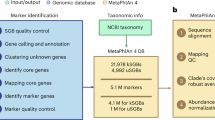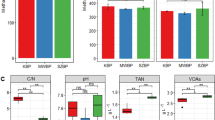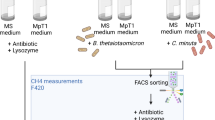Abstract
The genus Methanosphaera is a well-recognized but poorly characterized member of the mammalian gut microbiome, and distinctive from Methanobrevibacter smithii for its ability to induce a pro-inflammatory response in humans. Here we have used a combination of culture- and metagenomics-based approaches to expand the representation and information for the genus, which has supported the examination of their phylogeny and physiological capacity. Novel isolates of the genus Methanosphaera were recovered from bovine rumen digesta and human stool, with the bovine isolate remarkable for its large genome size relative to other Methanosphaera isolates from monogastric hosts. To substantiate this observation, we then recovered seven high-quality Methanosphaera-affiliated population genomes from ruminant and human gut metagenomic datasets. Our analyses confirm a monophyletic origin of Methanosphaera spp. and that the colonization of monogastric and ruminant hosts favors representatives of the genus with different genome sizes, reflecting differences in the genome content needed to persist in these different habitats.
Similar content being viewed by others
Log in or create a free account to read this content
Gain free access to this article, as well as selected content from this journal and more on nature.com
or
References
Brusa T, Canzi E, Allievi L, Puppo E, Ferrari A. Methanogens in the human intestinal tract and oral cavity. Curr Microbiol. 1993;27:261–5.
Evans PN, Hinds LA, Sly LI, McSweeney CS, Morrison M, Wright AD. Community composition and density of methanogens in the foregut of the Tammar wallaby (Macropus eugenii). Appl Environ Microbiol. 2009;75:2598–602.
Mao SY, Yang CF, Zhu WY. Phylogenetic analysis of methanogens in the pig feces. Curr Microbiol. 2011;62:1386–9.
Borrel G, McCann A, Deane J, Neto MC, Lynch DB, Brugere J-F, et al. Genomics and metagenomics of trimethylamine-utilizing Archaea in the human gut microbiome. ISME J. 2017;11:2059-2074.
Poulsen M, Schwab C, Borg Jensen B, Engberg RM, Spang A, Canibe N, et al. Methylotrophic methanogenic Thermoplasmata implicated in reduced methane emissions from bovine rumen. Nat Commun. 2013;4:1428.
Dridi B, Fardeau ML, Ollivier B, Raoult D, Drancourt M. Methanomassiliicoccus luminyensis gen. nov., sp. nov., a methanogenic archaeon isolated from human faeces. Int J Syst Evol Microbiol. 2012;62:1902–7.
Hansen EE, Lozupone CA, Rey FE, Wu M, Guruge JL, Narra A, et al. Pan-genome of the dominant human gut-associated archaeon, Methanobrevibacter smithii, studied in twins. Proc Natl Acad Sci USA. 2011;108:4599–606.
Leahy SC, Kelly WJ, Altermann E, Ronimus RS, Yeoman CJ, Pacheco DM, et al. The genome sequence of the rumen methanogen Methanobrevibacter ruminantium reveals new possibilities for controlling ruminant methane emissions. PLoS ONE. 2010;5:e8926.
Leahy SC, Kelly WJ, Li D, Li Y, Altermann E, Lambie SC, et al. The complete genome sequence of Methanobrevibacter sp. AbM4. Stand Genom Sci. 2013;8:215–27.
Rea S, Bowman JP, Popovski S, Pimm C, Wright A-DG. Methanobrevibacter millerae sp. nov. and Methanobrevibacter olleyae sp. nov., methanogens from the ovine and bovine rumen that can utilize formate for growth. Int J Syst Evolut Microbiol. 2007;57:450–6.
Miller TL, Wolin MJ. Methanosphaera stadtmaniae gen. nov., sp. nov.: a species that forms methane by reducing methanol with hydrogen. Arch Microbiol. 1985;141:116–22.
Thauer RK, Kaster AK, Seedorf H, Buckel W, Hedderich R. Methanogenic archaea: ecologically relevant differences in energy conservation. Nat Rev Microbiol. 2008;6:579–91.
Yan Z, Wang M, Ferry JG. A ferredoxin- and F420H2-dependent, electron-bifurcating, heterodisulfide reductase with homologs in the domains bacteria and archaea. MBio. 2017;8:e02285-16.
Gilmore SP, Henske JK, Sexton JA, Solomon KV, Seppala S, Yoo JI, et al. Genomic analysis of methanogenic archaea reveals a shift towards energy conservation. BMC Genom. 2017;18:639.
Biavati B, Vasta M, Ferry JG. Isolation and characterization of “Methanosphaera cuniculi” sp. nov. Appl Environ Microbiol. 1988;54:768–71.
Shi W, Moon CD, Leahy SC, Kang D, Froula J, Kittelmann S, et al. Methane yield phenotypes linked to differential gene expression in the sheep rumen microbiome. Genome Res. 2014;24:1517–25.
Hoedt EC, Cuiv PO, Evans PN, Smith WJM, McSweeney CS, Denman SE, et al. Differences down-under: alcohol-fueled methanogenesis by archaea present in Australian macropodids. ISME J. 2016;10:2376-88.
Blais Lecours P, Marsolais D, Cormier Y, Berberi M, Haché C, Bourdages R, et al. Increased Prevalence of Methanosphaera stadtmanae in Inflammatory Bowel Diseases. PLoS ONE. 2014;9:e87734.
Bernatchez E, Gold MJ, Langlois A, Blais-Lecours P, Boucher M, Duchaine C, et al. Methanosphaera stadtmanae induces a type IV hypersensitivity response in a mouse model of airway inflammation. Physiol Rep. 2017;5:e13163
Blais Lecours P, Duchaine C, Taillefer M, Tremblay C, Veillette M, Cormier Y, et al. Immunogenic properties of archaeal species found in Bioaerosols. PLoS ONE. 2011;6:e23326.
Joblin KN, Naylor GE, Williams AG. Effect of Methanobrevibacter smithii on xylanolytic activity of anaerobic ruminal fungi. Appl Environ Microbiol. 1990;56:2287–95.
Wright AD, Pimm C. Improved strategy for presumptive identification of methanogens using 16S riboprinting. J Microbiol Methods. 2003;55:337–49.
Kovarova-Kovar K, Egli T. Growth kinetics of suspended microbial cells: from single-substrate-controlled growth to mixed-substrate kinetics. Microbiol Mol Biol Rev. 1998;62:646–66.
Yu Z, Morrison M. Improved extraction of PCR-quality community DNA from digesta and fecal samples. BioTechniques. 2004;36:808–12.
Sullivan MJ, Ben Zakour NL, Forde BM, Stanton-Cook M, Beatson SA. Contiguity: contig adjacency graph construction and visualisation. PeerJ Prepr. 2015;3:e1273.
Parks DH, Imelfort M, Skennerton CT, Hugenholtz P, Tyson GW. CheckM: assessing the quality of microbial genomes recovered from isolates, single cells, and metagenomes. Genome Res. 2015;25:1043–55.
Aziz RK, Bartels D, Best AA, DeJongh M, Disz T, Edwards RA, et al. The RAST Server: rapid annotations using subsystems technology. BMC Genom. 2008;9:75.
Kanehisa M, Goto S. KEGG: Kyoto encyclopedia of genes and genomes. Nucleic Acids Res. 2000;28:27–30.
Markowitz VM, Chen I-MA, Palaniappan K, Chu K, Szeto E, Grechkin Y, et al. IMG: the integrated microbial genomes database and comparative analysis system. Nucleic Acids Res. 2012;40:D115–22.
Seemann T. Prokka: rapid prokaryotic genome annotation. Bioinformatics. 2014;30:2068–9.
Blom J, Albaum SP, Doppmeier D, Puhler A, Vorholter FJ, Zakrzewski M, et al. EDGAR: a software framework for the comparative analysis of prokaryotic genomes. BMC Bioinform. 2009;10:154.
Karlsson FH, Tremaroli V, Nookaew I, Bergstrom G, Behre CJ, Fagerberg B, et al. Gut metagenome in European women with normal, impaired and diabetic glucose control. Nature. 2013;498:99–103.
Bolger AM, Lohse M, Usadel B. Trimmomatic: a flexible trimmer for Illumina sequence data. Bioinformatics. 2014;30:2114–20.
Kang DD, Froula J, Egan R, Wang Z. MetaBAT, an efficient tool for accurately reconstructing single genomes from complex microbial communities. PeerJ. 2015;3:e1165.
Darling AE, Mau B, Perna NT. Progressive Mauve: multiple genome alignment with gene gain, loss and rearrangement. PLoS ONE. 2010;5:e11147.
Kumar S, Stecher G, Tamura K. MEGA7: Molecular Evolutionary Genetics Analysis Version 7.0 for Bigger Datasets. Molecular Biology and Evolution. 2017;33:1870-1874
Thompson JD, Higgins DG, Gibson TJ. CLUSTAL W: improving the sensitivity of progressive multiple sequence alignment through sequence weighting, position-specific gap penalties and weight matrix choice. Nucleic Acids Research. 1994;22:4673-4680
Parks DH, Rinke C, Chuvochina M, Chaumeil PA, Woodcroft BJ, Evans PN, et al. Recovery of nearly 8,000 metagenome-assembled genomes substantially expands the tree of life. Nat Microbiol. 2017;2:1533–1542
Price MN, Dehal PS, Arkin AP. FastTree 2 – approximately maximum-likelihood trees for large alignments. PLoS ONE. 2010;5:e9490.
Ludwig W, Strunk O, Westram R, Richter L, Meier H, Yadhukumar, et al. ARB: a software environment for sequence data. Nucleic Acids Res. 2004;32:1363–71.
Ashida H, Tamaki H, Fujimoto T, Yamamoto K, Kumagai H. Molecular cloning of cDNA encoding alpha-N-acetylgalactosaminidase from Acremonium sp. and its expression in yeast. Arch Biochem Biophys. 2000;384:305–10.
Balch WE, Fox GE, Magrum LJ, Woese CR, Wolfe RS. Methanogens: reevaluation of a unique biological group. Microbiol Rev. 1979;43:260–96.
Jarrell KF, Jones GM, Nair DB. Biosynthesis and role of N-linked glycosylation in cell surface structures of archaea with a focus on flagella and S layers. Int J Microbiol. 2010;2010:20.
Magidovich H, Eichler J. Glycosyltransferases and oligosaccharyltransferases in Archaea: putative components of the N-glycosylation pathway in the third domain of life. FEMS Microbiol Lett. 2009;300:122–30.
Konstantinidis KT, Ramette A, Tiedje JM. The bacterial species definition in the genomic era. Philos Trans R Soc B: Biol Sci. 2006;361:1929–40.
Kim M, Oh HS, Park SC, Chun J. Towards a taxonomic coherence between average nucleotide identity and 16S rRNA gene sequence similarity for species demarcation of prokaryotes. Int J Syst Evolut Microbiol. 2014;64:346–51.
Cayrou C, Henrissat B, Gouret P, Pontarotti P, Drancourt M. Peptidoglycan: a post-genomic analysis. BMC Microbiol. 2012;12:294.
Engelhardt Wv, Wolter S, Lawrenz H, Hemsley JA. Production of methalne in two non-ruminant herbivores. Comp Biochem Physiol Part A: Physiol. 1978;60:309–11.
Pinares-Patiño CS, Ebrahimi SH, McEwan JC, Dodds KG, Clark H, Luo D. Is rumen retention time implicated in sheep differences in methane emission? Proceedings of the New Zealand Society of Animal Production. 2011;71:219-222
Moeller AH, Caro-Quintero A, Mjungu D, Georgiev AV, Lonsdorf EV, Muller MN, et al. Cospeciation of gut microbiota with hominids. Science. 2016;353:380.
Acknowledgements
E.C.H. has been supported by an Australian Postgraduate Award. The financial support of Meat and Livestock Australia Limited via a Technical Assistance Grant (to E.C.H. project code B.STU.0257) as well as funds for project D.MHN.0617 (awarded to J.G.M. and P.R.G.) is gratefully acknowledged. This work has also been supported by funds (to M.M.) via CSIRO’s Science Leader scheme and The University of Queensland Diamantina Institute. The Translational Research Institute is supported by a grant from the Australian Government. The CSIRO projects 01200.035/B.CCH.6510 and 01200.038/B.CCH.6610 were funded by the Australian Government Department of Agriculture, and Meat & Livestock Australia Limited as part of the National Livestock Methane Program. P.Ó.C. is supported by a UQ Reginald Ferguson Research Fellowship in Gastroenterology. We are especially grateful for the technical assistance received with the PacBio sequencing of the BMS genome by Paul Lacaze in his past role with Millennium Science and Lawrie Wheeler (Queensland Institute of Technology), as well as gas chromatography analysis support by Mr Jagadish Padmanabha.
Author information
Authors and Affiliations
Corresponding author
Ethics declarations
Conflict of interest
The authors declare that they have no conflict of interest.
Ethical approval
E.C.H. planned and performed research and helped write the paper; D.H.P., J.G.V., C.P.R., C.S.M., S.E.D. and P.Ó.C. assisted with research and helped write the paper. P.R.G. and J.G.M. provided samples enabling Methanosphaera sp. PA5 isolation and helped with the preparation and review of the manuscript; and P.H., G.W.T., and M.M. planned and supervised research and wrote the paper.
Rights and permissions
About this article
Cite this article
Hoedt, E.C., Parks, D.H., Volmer, J.G. et al. Culture- and metagenomics-enabled analyses of the Methanosphaera genus reveals their monophyletic origin and differentiation according to genome size. ISME J 12, 2942–2953 (2018). https://doi.org/10.1038/s41396-018-0225-7
Received:
Revised:
Accepted:
Published:
Issue date:
DOI: https://doi.org/10.1038/s41396-018-0225-7
This article is cited by
-
Targeted isolation of H2-dependent methylotrophic methanogens by a cocktail approach
Nature Protocols (2025)
-
Novel complete methanogenic pathways in longitudinal genomic study of monogastric age-associated archaea
Animal Microbiome (2023)
-
Isolation and characterisation of novel Methanocorpusculum species indicates the genus is ancestrally host-associated
BMC Biology (2023)
-
Occurrence and expression of genes encoding methyl-compound production in rumen bacteria
Animal Microbiome (2019)



